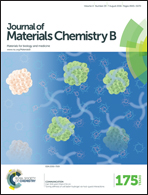Size-controllable ultrathin carboxylated polypyrrole nanotube transducer for extremely sensitive 17β-estradiol FET-type biosensors†
Abstract
17β-Estradiol is known as a steroid hormone in the human body but it is also known as a disruptor that can cause disequilibrium and dysfunction of the human immune system. Recently, there has been much interest in developing biosensors to detect low concentrations of 17β-estradiol. In this work, size-controllable aptamer conjugated ultrathin carboxylated polypyrrole nanotubes (A-UCPPyNTs) were fabricated as transducers in 17β-estradiol field-effect transistor (FET)-type biosensors. They were manufactured via a self-degradation method under several different conditions to control the diameter of the nanotubes. For targeting 17β-estradiol, the binding aptamers were immobilized through covalent bonding on its surface. The resulting A-UCPNT FET-type biosensor demonstrated p-type behavior with outstanding electrical conductivity, and exhibited Ohmic contacts between the samples and electrodes. The smaller diameter (40 nm) of ultrathin carboxylated polypyrrole nanotubes (UCPPyNTs) contributed to the biosensor's enhanced performance by generating a larger surface area, thereby increasing the number of conjugated binding aptamers. In conclusion, the A-UCPPyNT FET-type biosensor showed extremely high sensitivity (∼1 fM) toward 17β-estradiol, approximately 103 times more sensitive than the results found in other reports. Moreover, the A-UCPPyNT FET-type biosensor showed unique selectivity to the 17β-estradiol molecule, in addition to outstanding reusability and long-term storage stability (4 weeks of duration achieved in this work). These performances concerned with reusability and stability were achieved by the formation of covalent bonding in the anchorage to the substrate electrode. Thus this study can be effectively applied in biological and environmental fields.


 Please wait while we load your content...
Please wait while we load your content...